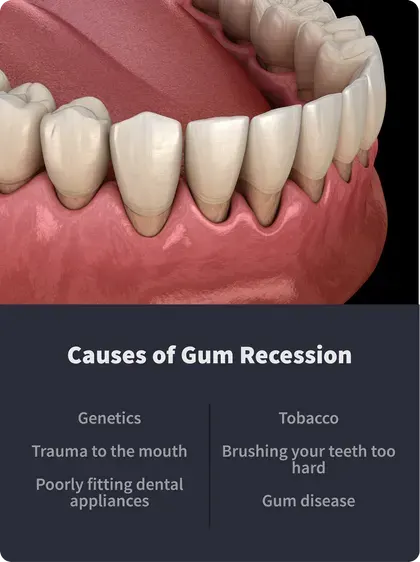Can Receding Gums Grow Back? Importance of Catching It Early

Table of Contents
- What Is Gum Recession?
- Can You Stop Gum Recession?
- Prevention
- Treatment Options
- References
You cannot regrow gums that have receded, but you can take steps to stop them from receding further and to prevent receding gums in the future.
Gum recession can cause teeth to look longer, cause sensitivity to hot or cold foods and drinks, and even lead to tooth decay and gum disease. Some people are genetically predisposed to thinner gums and gum recession, while others may struggle with gum infections that cause recession.
What Is Gum Recession?
Few people notice gum recession until it causes other problems with their oral health, but this condition can often be the first sign of gum disease like gingivitis or periodontitis, which is more severe.
Gum recession might be genetic. If left untreated, it can lead to other health issues. In some cases, gum recession might be a symptom of another problem that needs treatment.
Typically, healthy gums sit around the tooth like a cuff, but when gums begin to recede, the tooth might appear longer, part of the root could be exposed, and gums might form a dent or bump where they meet the tooth. You may not feel anything around the tooth where gum recession begins, or you may develop sensitivity to hot or cold foods, or to foods with lots of acid, spice, or sugar.
Reporting these changes to your dentist early means treatment can slow or stop gum recession, but serious gum recession might require surgery.
Can You Stop Gum Recession & Regrow Gums?

It is better to stop gum recession as soon as you notice it, so it does not get worse and lead to other oral health problems.
These are potential causes of gum recession:
Genetics: Some people have thinner gums than others, so they are more likely to develop problems with gum recession, even without an injury or infection. Some individuals also have larger tooth roots or attachment muscles, which might push gums out of the way.
Trauma: Injury to the mouth from an accident can cause gum recession.
Tobacco: All tobacco products are toxic and cause damage to your oral health, including to your gums. One sign of gum damage from tobacco use is recession.
Poorly fitting dental appliances: If you have a dental appliance like clear plastic aligners, retainers, bridges, or dentures that do not fit, this can cause problems with your gums that lead to recession. You are also likely to feel discomfort or pain.
Brushing your teeth too hard: Lots of people use too much pressure, brush their gums too hard, or use a toothbrush with hard bristles. This can cause gum recession from constant irritation.
Gum disease: Gingivitis and periodontitis are gum infections that can trigger gum recession. These are also often accompanied by bad breath, reddened gums, sensitivity at the tooth’s root, bleeding after brushing teeth, and tooth decay
If gums have receded so the root is exposed, there are some options your dentist will offer, depending on how serious the problem is. The underlying cause must also be addressed to prevent further gum recession or additional oral health problems.
You can stop, slow, or prevent gum recession, but once gums have receded, they will not grow back.
Preventing Receding Gums
While you cannot regrow gums that have receded, you can take steps to prevent the problem, especially if you know you are at higher risk of developing the problem.
Here are some steps to reduce the impact on your gums and prevent gum recession:
Brush your teeth gently, with a soft-bristled brush, at a 45-degree angle.
Make sure your toothbrush fits in your mouth so you can reach all your teeth. Be sure to replace it every 3 to 4 months.
Clean between your teeth at least once per day, and brush your teeth at least twice per day.
Reduce how much sugary or acidic foods and drinks you consume.
Go to your dentist regularly for cleanings and checkups.
Use a non-irritating mouthwash, perhaps one that does not have alcohol, or make a saline rinse for yourself at home.
Quit using tobacco products, including cigarettes or vape pens. This might involve a visit to your doctor for support.
Discuss any signs of gum disease with your dentist and follow their prescribed treatment plan.
Make sure oral devices like clear teeth aligners fit properly.
Taking steps to prevent gum recession can reduce your risk of gum disease and other associated oral health problems. This can help to keep your smile glowing.
Treatment Options for Receding Gums
Just because your gums have started receding (or even if they are in an advanced state of recession), it doesn’t mean there’s nothing you can do about it. You can’t grow your gums back, but you can take action to ensure your gum problems don’t get worse.
It’s important to remember that gum issues are serious. Not only do they indicate the risk of gum disease (periodontitis), which is a leading cause of oral health problems, but they could be a risk factor for other chronic health problems.
Gum issues are linked to cardiovascular disease, pregnancy complications, diabetes, and respiratory conditions — just to name a few.
While more research needs to be done to establish the exact relationship between these conditions and gum disease, experts believe the association lies in inflammation. Inflammation affects the body’s immune system and is considered a main factor in chronic illness.
By caring for your gums and halting gum damage and inflammation, you can improve your overall health and reduce the risk of chronic illness.
Treatment for receding gums includes the following:
Deep cleaning: A deep dental cleaning isn’t just a more in-depth regular cleaning. It’s a special technique of removing tartar, plaque, and buildup above and below the gumline using specialized tools. A deep cleaning is also called scaling and root planing. The process can take a few dental visits and may require general anesthesia. Your dentist will tell you if you are a candidate for deep cleaning.
Gum reshaping and contouring: If your gum recession isn’t due to gum disease, you may consider gum reshaping, also called gum contouring. In this procedure, a dentist (often a cosmetic dentist) reshapes your gum using a laser or scalpel.Gum contouring is usually done only for cosmetic purposes, although it may make your gums easier to clean by creating a clearer, straighter gumline.
Gum grafting: If your gums have receded to the point where the root is exposed, your dentist may recommend a gum graft surgery, in which tissue (often from your palate) is applied to the gums and exposed root.
Gum regeneration: Often considered a last resort for gum restoration, gum regeneration is performed by pulling the gums back and allowing a bone graft or other material to be placed on the gums in order to trigger regeneration and growth.
